Chemical risk assessment in food animals via physiologically based pharmacokinetic modeling − Part I: Veterinary drugs on human food safety assessment
IF 10.3
1区 环境科学与生态学
Q1 ENVIRONMENTAL SCIENCES
引用次数: 0
Abstract
Veterinary drugs and environmental pollutants can enter food animals and remain as residues in food chains threatening human food safety and health. Performing health risk and food safety assessments to derive safety levels of these xenobiotics can protect human health. Physiologically based pharmacokinetic (PBPK) modeling is a mathematical tool to quantitatively describe chemical disposition in humans and animals informing human food safety and health risk assessments. However, few reviews focus on the application of PBPK models in food animals and discuss their relationship to human food safety and health risk assessments in the last five years (2020–2024). In this series of reviews, we introduce the methodology, recent progress and challenges of PBPK modeling in food animals. The present review is Part I of this series of reviews and it focuses on applications of PBPK models of veterinary drugs in food animals, whereas Part II is a companion review focusing on environmental chemicals. Advanced strategies of PBPK modeling in risk and food safety assessment, including population PBPK, interactive PBPK web dashboard, and generic PBPK are also summarized in Part I. Additionally, we share our perspective on the existing challenges and future direction for PBPK modeling of veterinary medicines in food animals.
求助全文
约1分钟内获得全文
求助全文
来源期刊

Environment International
环境科学-环境科学
CiteScore
21.90
自引率
3.40%
发文量
734
审稿时长
2.8 months
期刊介绍:
Environmental Health publishes manuscripts focusing on critical aspects of environmental and occupational medicine, including studies in toxicology and epidemiology, to illuminate the human health implications of exposure to environmental hazards. The journal adopts an open-access model and practices open peer review.
It caters to scientists and practitioners across all environmental science domains, directly or indirectly impacting human health and well-being. With a commitment to enhancing the prevention of environmentally-related health risks, Environmental Health serves as a public health journal for the community and scientists engaged in matters of public health significance concerning the environment.
 求助内容:
求助内容: 应助结果提醒方式:
应助结果提醒方式:


